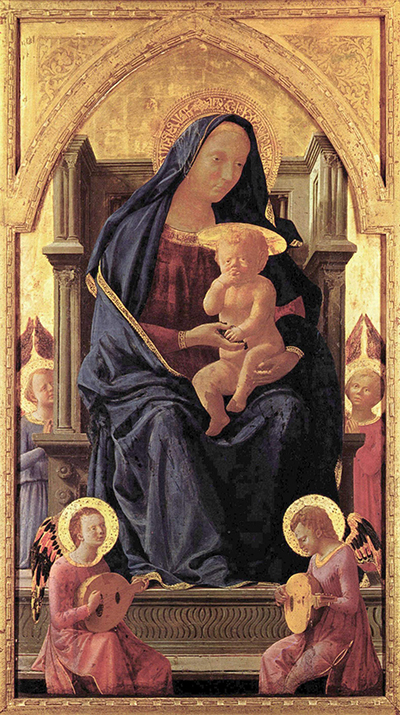Early renaissance artist and founding father, Masaccio, displays an array of figures and structures within his famous painting, Maria and Child
The artwork illustrates the female head of the Roman Catholic religion, Mother Mary, holding her new-born child Jesus Christ. The artist had already focused his work on displaying Mother Mary and Jesus paired with one another in his artwork already, as evident in Madonna of Humility, and Madonna Casini.
Maria and Child showcases a different style in which Masaccio is portraying the holy figure as he focused on a 3D approach instead of the flattened viewpoint he previously portrayed. The artwork is the central panel of the Pisa alter piece, a common chapel that Masaccio painted his work for. The artwork was executed for the chapel of St. Julian located in Italy.
The artwork contains four figures, mother and child, and four angels. The virgin Madonna is the central figure of the artwork as in all of Masaccio's paintings portraying her, and is painted much larger than the other figures to display her significance. Jesus Christ is seated at her knee as she lightly holds him as he is showcased in his infant form.
The classic colours that Mother Mary is known for is a royal blue cloak paired with a rich red textile under. The artist covers her in this colour as he covers head, but still lets a glimpse of her blonde hair fall. Her clothing is accentuated by small gold glimpses of fabric covering the perimeter of the outfit.
The Virgin mother's body is slightly tilted to the side as she turns her head to the right stirring towards the floor. The woman is seized by something in the distance or by an internal thought that captivates her being as the emotion on her face is swept away. The lack of characterÊdisplayed on her face causes the viewer to wonder what emotion she truly holds, whether perhaps she is aware of her sons early death in the future and is pondering it.
The interesting element to witness in the artwork is the tall throne in which the figure is seated at, showing her immense significance to the religion. Masaccio had painted a gold aura over her head in a golden shade showing her purity and religious significance. The child is painted with a similar spirit around his head showcasing his essence.
As Masaccio was one of the first founding fathers of the renaissance period, he had incorporated gothic architecture in his work through the arched panels that line the top of the artwork. The carved background stone was a common characteristic within Italian archetypes during the period. The detailed ceiling above the arch showcases renaissance architecture within the artwork.
Masaccio was a brilliant artist who carried the ability to incorporate an array of detail and character within his artwork, not solemnly focusing on the story but rather an array of detail adding to it.




